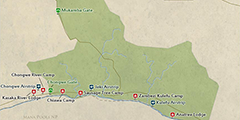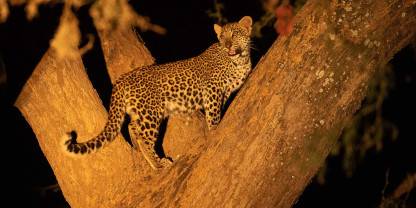Lower Zambezi National Park hugs the northern bank of the mighty Zambezi River. Wildlife is plentiful, with four of the Big Five easily spotted (rhino is absent). Whether you enjoy the tranquility of a sunset cruise or the adrenaline rush of a canoe safari, you shouldn’t leave here without spending time on the river. Nowhere else can you see so much wildlife from this exciting vantage point.

-
Best Time To Go
- July to October (Animals are easy to find)
-
High Season
- July to September (Busy and high-season rates apply)
-
Size
- 4,092km² / 1,580mi²
-
Altitude
-
339-1,387m /1,112-4,551ft
 View Photos
View Photos
 View Photos
+24
Photos
View Photos
+24
Photos
 Open Map
Open Map
Pros & Cons
- Excellent wildlife viewing with four of the Big Five present
- Beautiful setting at one of Africa’s most magnificent rivers
- Great night drives, walking and boat safaris
- Short canoe excursions as well as multiday canoe trips
- Tiger fishing available
- All budget accommodation is outside the park
- Best wildlife viewing is deep in the park, accessible to a few lodges only
Wildlife
Elephants are abundant. Big male tuskers stand on their hind legs like acrobats to reach tasty pods high in the trees. And watching a breeding herd cross the river with the mothers guiding their calves against the current is very special too. For canoers, most memorable are the thousands of hippos that inhabit the river channels and the enormous crocs lying on the banks.
More about Lower Zambezi’s wildlifeScenery
The park’s main feature is one of Africa’s most famous rivers – the Zambezi. The northern boundary of the park is the forested Muchinga escarpment, which forms an impressive backdrop to the river in the valley. Sandy flats, mopane woodland and acacia shrubs fringe the waterways. Beautiful winterthorn groves offer shade for an abundance of animals in a park-like setting.
Weather & Climate
Lower Zambezi has a clear-cut Wet season (November to April) when the temperatures are generally hot, and afternoon showers sweep in to temporarily take the edge off the heat. The park’s Dry season (May to October) is a milder period, although temperatures pick up in September and soar in October.
More about the weather and climateBest Time To Visit
The best time to visit Lower Zambezi is between July and October – the middle and end of the Dry season. This is when wildlife viewing is at its best. Mind though that October is uncomfortably hot and humid. Although the first rains bring some relief, the heat and humidity can be oppressive throughout the Wet season (November to April).
More about the best time to visit



